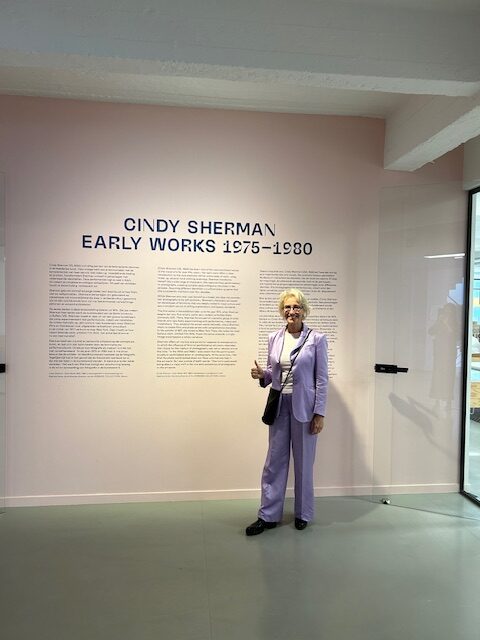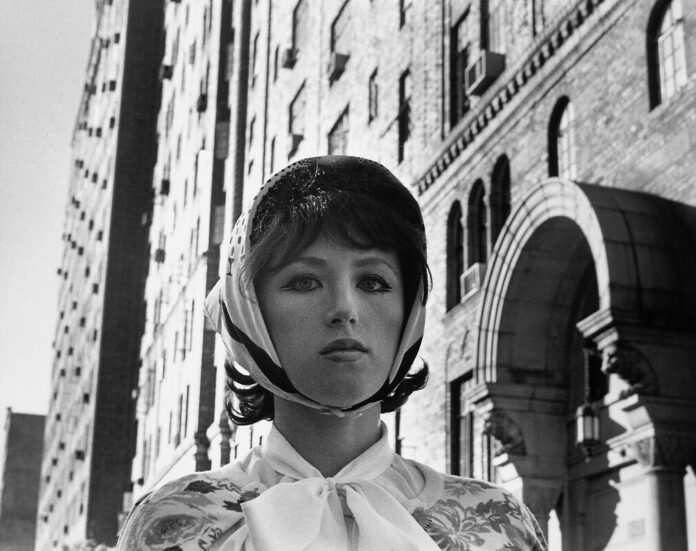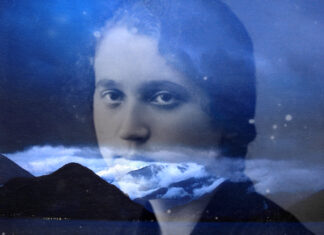Untitled Film Still #17, 1978, Gelatin silver print © Cindy Sherman, Courtesy the artist and Hauser & Wirth
On the occasion of the very unique exhibition of Cindy Sherman at FOMU-Photomuseum Antwerp connected to Ensor season, the first show in Belgium dedicated to the artist, meeting with Gabriele Schor, Founding Director of the VERBUND COLLECTION, Vienna. As a curator of the section Cindy Sherman – Early Works 1975 – 1980 she is telling us how these works offer key elements to understand her entire body of work, and especially her most famous corpus Untitled Film Stills created at her arrival in New York in 1977. Questioning stereotypes of femininity and stifling expectations on beauty standards, Sherman offers a personal response to conceptual art during that period. Gabriele Schor as the creator of the expression: “avant-garde féministe” connected to the major touring exhibition in Europe and publication, gives us her vision of such a concept and the vocation of the VERBUND COLLECTION that she founded in Vienna in 2004.
À l’occasion de l’exposition majeure de Cindy Sherman au FOMU Photomuseum d’Anvers, dans le cadre de la saison Ensor, la première monographie en Belgique consacrée à l’artiste, rencontre avec Gabriele Schor, directrice fondatrice de la VERBUND COLLECTION, à Vienne. En tant que commissaire de la section Cindy Sherman – Early Works 1975 – 1980, elle nous explique comment ces œuvres offrent des éléments clés pour comprendre l’ensemble de son travail, et en particulier son corpus le plus célèbre, Untitled Film Stills, créé à son arrivée à New York en 1977. Remettant en question les stéréotypes de la féminité et les attentes étouffantes en matière de normes de beauté, Sherman offre une réponse personnelle à l’art conceptuel de cette période. Gabriele Schor à l’origine de l’expression : « avant-garde féministe » liée à la grande exposition itinérante en Europe et à publication associée, nous donne sa vision d’un tel concept et la vocation de la COLLECTION VERBUND qu’elle a fondée à Vienne en 2004.
Dr. Gabriele Schor is an author and exhibitions curator. Since 2004 she is the founding director of the VERBUND COLLECTION in Vienna (Austria) and has defined its distinctive intellectual profile. Schor has edited numerous monographs such as: Birgit Jürgenssen (with Abigail Solomon-Godeau, 2009), Francesca Woodman (with Elisabeth Bronfen, 2014), Renate Bertlmann (with Jessica Morgan, 2016), Louise Lawler (2018) and ORLAN (with Catherine Morris, 2023). Schor is the author of The Prints of Barnett Newman (1996) and the catalogue raisonné of Cindy Sherman: The Early Works, 1975–77 (published in 2012). In 2015 she edited the book Feminist Avant-Garde of the 1970s, a term which she coined to highlight the pioneering achievements of these female artists. The corresponding show is touring through Europe.
Dr Gabriele Schor est auteur et commissaire d’expositions. Depuis 2004, elle est la directrice fondatrice de la COLLECTION VERBUND à Vienne (Autriche), dont elle a défini l’ADN et champ d’action. Schor a édité de nombreuses monographies telles que : Birgit Jürgenssen (avec Abigail Solomon-Godeau, 2009), Francesca Woodman (avec Elisabeth Bronfen, 2014), Renate Bertlmann (avec Jessica Morgan, 2016), Louise Lawler (2018) et ORLAN (avec Catherine Morris, 2023). Schor est l’auteur de The Prints of Barnett Newman (1996) et du catalogue raisonné de Cindy Sherman : The Early Works, 1975-77, publié en 2012. En 2015, elle a fait paraitre le livre « Avant-Garde féministe » photographies et performances des années 1970, un terme qu’elle a inventé pour mettre en lumière les réalisations pionnières de ces femmes artistes. L’exposition correspondante est en tournée en Europe.

Gabriele Schor à l’entrée de l’exposition Cindy Sherman Early Works 1975 – 1980 FOMU photo Gabriele Schor
- What is your definition of feminist avant-garde ?
I created this term and combined those two words together – « feminism » and « avant-garde » because ‘avant-garde’ gathers artists creating something that was not in the art world before, aiming also to transform the society. The term ‘feminism’ is willing to reflect the situation of women during decades. The feminist art movement of the 1970s is one of the most important phenomena in the art history, but this important movement was overseen by the canon of art history and the art works were not collected by museums. For the first time in the history of art female artists began to create their own new self-determined image of women. The works are reflecting on stereotypes of motherhood, wife and housewife, on a general feeling of being locked-up, on questioning of dictates of beauty and representations of female bodies, on explorations of female sexuality and the works creates and debates around female roles and identities like Cindy Sherman’s early works and her Untitled Film Stills (1977-80).
Quelle est votre définition de « l’avant-garde féministe » ?
J’ai créé ce terme en combinant ces deux mots – « féminisme » et « avant-garde » – parce que l’« avant-garde » réunit des artistes qui créent quelque chose qui n’existait pas auparavant dans le monde de l’art, visant également à transformer la société. Le terme « féminisme » désire traduire la situation des femmes au cours des décennies. Le mouvement artistique féministe des années 1970 est l’un des phénomènes les plus marquants de l’histoire de l’art, mais ce mouvement important a été supervisé à travers le canon de l’histoire de l’art et les œuvres d’art n’ont pas été collectionnées par les musées. Pour la première fois dans l’histoire de l’art, des femmes artistes ont commencé à créer leur propre vision de la femme. Les œuvres reflètent les stéréotypes de la maternité, de l’épouse et de la femme au foyer, le sentiment général d’enfermement, la remise en question des diktats de la beauté et des représentations du corps féminin, les explorations de la sexualité féminine et les œuvres créent et questionnement les rôles et les identités féminines, comme les premières œuvres de Cindy Sherman et ses Untitled Film Stills (1977-80).

Vue de l’exposition Cindy Sherman Early Works 1975 – 1980 FOMU photo Gabriele Schor
- Does Cindy Sherman consider herself a feminist?
Cindy Sherman, as many artists, don’t want that her work is reduced to one term. You can’t summarize her long and creative process to one label called feminism. However, she is comfortable with the appellation of ‘feminist avant-garde’ from the 1970s. Like other female artists, choosing the medium of photography was avant-garde at that time and was not mainstream at all in the art world. Bringing the female body into the art world as a woman was also new.
Cindy Sherman se considère-t-elle comme féministe ?
Cindy Sherman, comme beaucoup d’artistes, ne veut pas que son travail soit réduit à un seul terme. Il est impossible de résumer son long processus créatif à un seul label, celui du féminisme. Cependant, elle se sent à l’aise avec l’appellation « avant-garde féministe » des années 1970. Comme d’autres artistes féminines, elle a choisi la photographie comme mode d’expression, ce qui était avant-gardiste à l’époque et n’était pas du tout une tendance dominante dans le monde de l’art. Faire entrer le corps féminin dans le champ de l’art en tant que femme était également une nouveauté.

Vue de l’exposition Cindy Sherman Early Works 1975 – 1980 FOMU photo Gabriele Schor
- How did Sherman’s Early works announce her upcoming commitments?
In her oeuvre she speaks about her experience of being a woman in our society. That runs like a red thread through your whole work. For example, when we look at her early work that she created as a student in Buffalo, we can already see a feminist statement. In 1975 she cuts out her staged figures out of photographic paper and using these small paper dolls to create the animated film Doll Clothes which tells the silent story of failure. A young woman chooses a dress and looks at herself in the mirror. In this moment, a human hand approaches the doll, tears the dress off her body and puts her back into a plastic sleeve. So the paper doll is not supposed to succeed in gaining its self-defined subjectivity. The hand symbolizes a society that prevents a woman from being creative and self-determined. After the film she produced complex stories such us the Murder Mystery story.
When she left Buffalo, she stopped cutting out her figures. In New York City she started with her famous Untitled Film Stills and wanted to find a way to fit a narrative into a single image. The small black and white photographs are reminiscent of the look of the 1940s to 1960s, of the film noir aesthetic of Alfred Hitchcock, without copying scenes from specific films. The women correspond to stereotypes of this film aesthetic, are in indefinable places and often on their way to an unknown destination.
Comment les premières œuvres de Sherman annoncent-elles ses engagements à venir ?
Dans son œuvre, elle parle de son expérience en tant que femme dans notre société. C’est un peu le fil rouge de toute son œuvre. Par exemple, lorsqu’on regarde ses premières œuvres, réalisées alors qu’elle était étudiante à Buffalo, on peut déjà y voir un manifeste féministe. En 1975, elle découpe ses personnages mis en scène dans du papier photographique et utilise ces petites poupées de papier pour créer le film d’animation Doll Clothes, qui raconte l’histoire silencieuse d’un échec. Une jeune femme choisit une robe et se regarde dans le miroir. À ce moment-là, une main humaine s’approche de la poupée, lui arrache la robe et la remet dans une pochette en plastique. La poupée de papier n’est donc pas censée réussir à acquérir la subjectivité qu’elle s’est elle-même définie. La main symbolise une société qui empêche la femme d’être créative et autodéterminée. Après le film, elle a produit des histoires complexes telles que Murder Mystery.
Lorsqu’elle quitte Buffalo, elle cesse de découper ses personnages. À New York, elle a commencé avec ses célèbres Untitled Film Stills et a voulu trouver un moyen de faire tenir une narration dans une seule image. Les petites photographies en noir et blanc rappellent le look des années 1940 à 1960, l’esthétique du film noir d’Alfred Hitchcock, sans pour autant copier des scènes de films spécifiques. Les femmes correspondent aux stéréotypes de cette esthétique cinématographique, elles sont dans des lieux indéfinissables et souvent en route vers une destination inconnue.
- What is the vocation of the Verbund Collection?
VERBUND COLLECTION’s maxim is “depth instead of breadth”. Our purpose is to show works by female artists rarely seen in the art world, according to the impact they had in the 1970s. Art historiography has tended to overlook the works of women artists. This has changed in the last few decades. More women are present as museum directors and curators with a gender sensibility to understand more the value of these works and now male museum director and curators follow this sensibility. We see the achievements of the avant-gardes by female artists such as of the constructivism or surrealism and we recognize that there was also an avant-garde in the 1970s by feminist artists. I am pleased that together with my team we could discover many of these important artists and they are now international visible.
Quelle est la vocation de la Verbund Collection ?
La devise de VERBUND COLLECTION est « la profondeur plutôt que l’étendue ». Notre objectif est de montrer des œuvres d’artistes féminines rarement vues dans le monde de l’art, en fonction de l’impact qu’elles ont eu dans les années 1970. L’historiographie de l’art a eu tendance à négliger les œuvres des femmes artistes. Cette situation a changé au cours des dernières décennies. De plus en plus de femmes sont présentes en tant que directrices de musée et conservatrices, avec une sensibilité au genre qui leur permet de mieux comprendre la valeur de ces œuvres, et les directeurs de musée et conservateurs masculins suivent désormais cette sensibilité. Nous voyons les réalisations des avant-gardes par des artistes féminines telles que le constructivisme ou le surréalisme et nous reconnaissons qu’il y a également eu une avant-garde d’artistes féministes dans les années 1970. Je suis heureuse qu’avec mon équipe, nous ayons pu découvrir un grand nombre de ces artistes importantes et qu’elles soient aujourd’hui visibles au niveau international.
- The 20th anniversary exhibition of the VERBUND COLLECTION took place at the Albertina museum in Vienna last spring. What did you show?
The exhibition was divided into three sections. In the first part of the show, Cindy Sherman’s early works were presented side by side with works by contemporaries like Martha Wilson, Susanne Lacy as well as younger artists like Aneta Grzeszykowska, who reenacted Sherman’s famous black-and-white series Untitled Film Stillsin color. The juxtaposition of Birgit Jürgenssen and Francesca Woodman was also exciting to see. They were followed by works of the feminist avant-garde. Another section was dedicated to works dealing with conceptual, poetic, and psychological perception of spaces and places such as Gordon Matta-Clark, David Wojnarowicz and Ernesto Neto. Finally the exhibition presents new acquisitions in the context of ‘Gender, Identity & Diversity’ works by Lebohang Kganye, Alexander Ugay, Frida Orupabo or Zanele Muholi, that have never been shown in Austria before.
L’exposition du 20e anniversaire de la COLLECTION VERBUND a eu lieu au musée Albertina de Vienne au printemps dernier. Qu’avez-vous exposé ?
L’exposition était divisée en trois sections. Dans la première partie de l’exposition, les premières œuvres de Cindy Sherman étaient présentées côte à côte avec des œuvres de contemporaines comme Martha Wilson, Susanne Lacy ainsi que des artistes plus jeunes comme Aneta Grzeszykowska, qui a rejoué en couleur la célèbre série en noir et blanc Untitled Film Stills. La juxtaposition de Birgit Jürgenssen et de Francesca Woodman était également passionnante. Elles étaient suivies par des œuvres de l’avant-garde féministe. Une autre section était consacrée à des œuvres traitant de la perception conceptuelle, poétique et psychologique des espaces et des lieux, comme Gordon Matta-Clark, David Wojnarowicz et Ernesto Neto. Enfin, l’exposition présentait de nouvelles acquisitions dans le contexte de « Gender, Identity & Diversity », avec des œuvres de Lebohang Kganye, Alexander Ugay, Frida Orupabo ou Zanele Muholi, qui n’avaient jamais été exposé.es en Autriche auparavant.
- How many pieces do you have in the VERBUND COLLECTION, Vienna?
The collection holds around one thousand works by two hundred artists following an in-depth collecting. The feminist avant-garde is gathering 600 works by 87 female artists.
Combien d’oeuvres avez-vous dans la COLLECTION VERBUND, Vienne ?
La collection compte un millier d’œuvres de deux cents artistes à la suite d’un travail de collecte approfondi. L’avant-garde féministe rassemble 600 œuvres de 87 artistes femmes.
Practical Infos/ Infos pratiques
Cindy Sherman Early Works 1975 – 1980
Cindy Sherman Anti-fashion
FoMu, Musée de la Photographie Anvers
28.09.24 – 02.02.25
https://fomu.be/fr/expositions/cindy-sherman
More about the VERBUND COLLECTION Vienna/ En savoir plus sur la VERBUND COLLECTION
Advisory board of the VERBUND COLLECTION, Vienna
JAMILLAH JAMES
Senior Curator, Museum of Contemporary Art Chicago
CATHERINE WOOD
Director of program, Tate Modern, London
GABRIELE SCHOR
Founding Director, VERBUND COLLECTION Vienna
The tour of the Feminist Avant-Garde shows with works by the VERBUND COLLECTION, Vienna started in 2010 in Rome and is still going on. The next venues of the tour will take place at: Les prochaines étapes de l’exposition itinérante :
Staatsgalerie Stuttgart, Deutschland
Feministische Avantgarde
Fr. 21. March – 22. June 2025
Sprengel Museum Hannover, Deutschland
Feministische Avantgarde
Fr. 4. July – 21. September 2025
MAC, Museu de Arte Contemporanea da Universidade de Sao Paulo, Brasilien
Feminist Avant-Garde
Fr. 28. March – 28. June 2026
Other exhibition by VERBUND COLLECTION/ Autres expositions de la VERBUND COLLECTION
Francesca Woodman at ALBERTINA, Wien
3. April 2025 – July 2025
Birgit Jürgenssen at ALBERTINA, Wien
13. March – 14. June 2026
In 2025 we present a film on the Feminist Avant-Garde artists by the director Susanne Riegler. Sortie du film en 2025 sur l’Avant-garde féministe par la réalisatrice Susanne Riegler.
Discover the other shows Ensor24 at Antwerp / Découvrir les autres temps forts Ensor24 à Anvers :
MoMu : Masquerade, Make-up & Ensor
Jusqu’au 02/02/2025
https://www.momu.be/fr/expositions/ensor
KMSKA : Ensor, In Your Wildest Dreams
https://kmska.be/fr/james-ensor
Organiser votre venue à Anvers :



![Rencontre Evelyne Deret, ART [ ] COLLECTOR- « Des Collectionneurs invitent un Artiste »](https://fomo-vox.com/wp-content/uploads/2025/12/DSC7937-218x150.jpg)


![Rencontre Evelyne Deret, ART [ ] COLLECTOR- « Des Collectionneurs invitent un Artiste »](https://fomo-vox.com/wp-content/uploads/2025/12/DSC7937-100x70.jpg)

